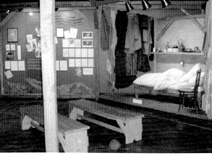
In spite of the harsh conditions, some events in Theresienstadt gave the prisoners hope. Through their own efforts, the prison became a place where music, art, and poetry thrived. These activities helped everyone, especially the children, put up with the misery of their lives. When they created art and music, they dreamed of home, and remembered happier times.
Though school was not permitted in the camp, the adults were determined to continue educating the young people. Every day, the children learned from talented fellow prisoners – artists, writers, musicians, and actors. Lessons were taught in the attics of the barracks, where the guards were less likely to discover them. Older children stood guard at the doors, on alert in case the guards came close by.
There were no textbooks. Instead, the teachers talked to their pupils and encouraged discussions about math, history, and literature. The children wrote stories and painted pictures. They sang songs, and talked about a future when they would all return to their homes and resume their lives. They participated in plays and musical events. They had chess tournaments and political discussions. There were even some sporting competitions. In every way, the prisoners tried to turn their unbearable living situation into something positive and good.
One day, Arna gathered the boys of John’s room together for a meeting. Over the months he had become more than a leader; he acted as parent, teacher, counselor, and friend to the boys, doing his best to help them grow into young men. “As difficult as it is to be here, we have to learn to survive,” he explained. “We have to find ways to be creative and keep our spirits high.” He suggested that they might produce a newspaper for themselves and the others. Anyone would be able to contribute articles. The newspaper was to be called Bobrick, a Czech word for “beaver.”
Once a month, the stories, poems, and articles written by the children would be collected into a single edition of the newspaper that would be circulated in the barracks for everyone to read. Everything would be handwritten, since there was no typewriter. When the paper was finished, Arna would gather them all in the room so that it could be read aloud, while the older children stood watch at the door. Just like Klepy, this paper would be created and enjoyed in secret.
John could not believe what he was hearing. A newspaper here in Theresienstadt? He thought he had left writing behind when he left Budejovice. He listened carefully to what Arna was saying – that the boys needed to find ways to be creative, that writing was a way to use your mind, a way to feel connected to other people and to fight against rules and restrictions. This was the same appeal that Ruda Stadler had made for Klepy, to all the children of Budejovice.

Children in Theresienstadt watched plays performed in attic rooms like this one.
His mind wandered back to the days when he had been part of Klepy. He had felt so productive and motivated then. As soon as the meeting was over, he set to work. He wanted to contribute something to this newspaper. With a dull pencil and a dirty piece of paper, he sat in his bunk and wrote a poem that he would contribute to Bobrick.
It has been five years
Since the devil marched into our peaceful land.
Death has moved from house to house.
War has brought terrible times.
Mothers and daughters light candles,
Remembering those beloved
They will never see again.
John never saw Ruda in Theresienstadt, but he knew that Ruda would be proud. We are doing just what he inspired us to do at home, thought John. Klepy had allowed them to show their resistance in Budejovice, by using their imaginations. Bobrick would do the same thing here in the squalor of Theresienstadt.